This soft rye sandwich bread has a delicious tangy flavor from rye flour, sourdough starter discard, plus a secret ingredient. Easy to slice, it's perfect for sandwiches or toasted and slathered with butter!
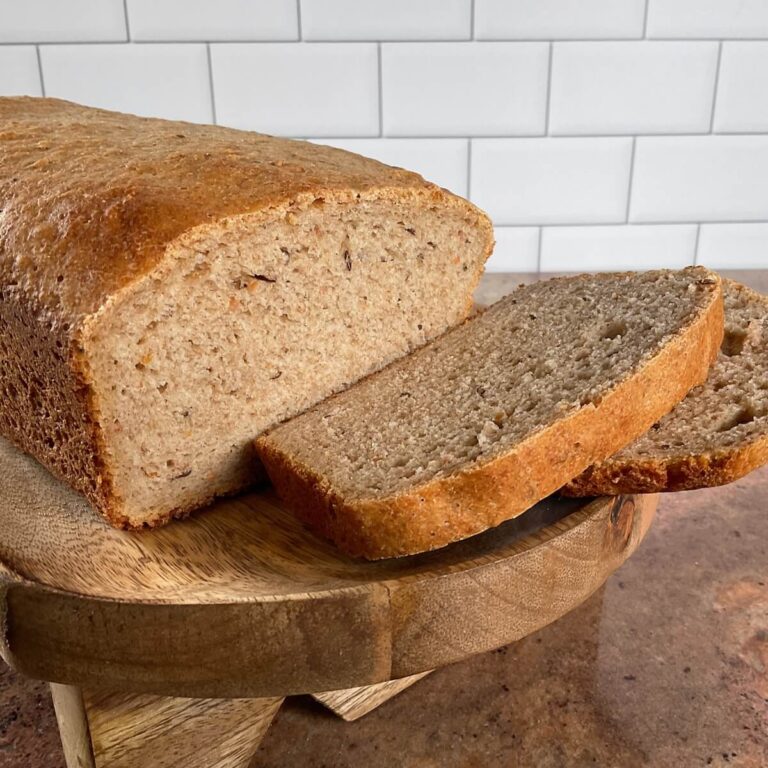
Jump to:
[February, 2024: I've reworked the recipe and updated this post with all new pictures. Enjoy!]
Why this recipe works
- This rye bread has a tangy rye flavor that's complemented by unfed sourdough starter and dill pickle juice
- A soft, sliceable bread perfect for sandwiches and toast
- Includes two ways to shape basic sandwich bread dough
I love rye bread. The standard Jewish rye bread is the one with which I’m most familiar. You know, the one from the deli that's used for pastrami and corned beef sandwiches. It’s also the best to have with your eggs, toasted with butter (wiping drool off keyboard now).
As someone who maintains sourdough starter, I'm always on the hunt for recipes that I can adapt to use unfed sourdough starter. This easy sourdough rye bread not only has a tangy flavor from the sourdough starter discard, dill pickle juice contributes its tanginess to really pile on the flavor.
Soft and sliceable, this is a rye bread recipe any sandwich-eater will love!
I mentioned above that I’m most familiar with Jewish rye bread, and this Sourdough Rye Sandwich Bread recipe takes rye bread in a new and exciting direction. It has a different flavor altogether, tangy from the sourdough with a slight sourness that echoes of dill pickles.
The loaf slices up nicely, and the texture is terrific. It's especially good for patty melts and as buttered rye toast for breakfast. So not only do I have another use for my weekly sourdough starter discard, I have a deliciously different rye bread for sandwiches and melts.
Here's an idea - make Dutch Oven Corned Beef or Slow Cooker Corned Beef & Cabbage for dinner, then use the leftovers to make corned beef sandwiches. Yum!
⭐⭐⭐⭐⭐
Yummy! This was a great bread to use with our corned beef for post-St Patrick’s Day Reubens!
- Summer
Recipe Ingredients
You'll need the following ingredients to make this sourdough rye bread recipe:
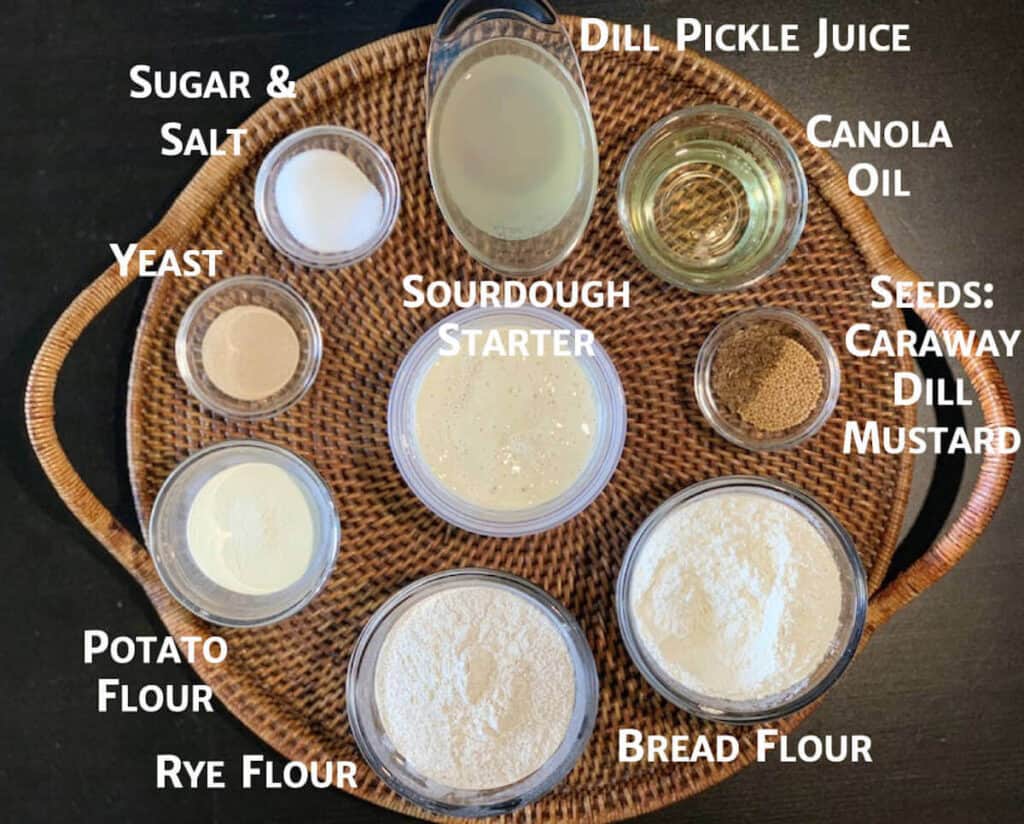
Ingredient Notes
Flour: This rye bread recipe uses a mixture of rye flour and bread flour. Rye flour has a lower protein content than wheat flour, so the higher protein content in bread flour provides structure to help the dough rise.
Sourdough starter discard: Sourdough discard is unfed sourdough starter, i.e. the amount you remove from your crock before feeding the remainder (I do this weekly). Since it's not active starter, it's used for flavor rather than fermentation (you'll need yeast for that).
Potato flour: Helps keep the rye bread light and fluffy. If you choose not to use potato flour, increase the amount of bread flour to compensate.
Pickle juice: The secret ingredient that adds a flavorful undertone to this rye bread!
Yeast: I use instant yeast in all my baking, but you can also use Active Dry yeast. If you use Active Dry yeast, then you might want to sprinkle yeast on to the warmed pickle juice with a teaspoon of sugar and allow it to sit for a few minutes before proceeding with the recipe. Letting it foam "proves" the yeast is active and ready to go to work.
If you'd like to omit the yeast and just use fed, active sourdough starter, see the instructions below.
Mix-ins: Rye bread is traditionally caraway seeds that add that distinctive anise quality present in rye bread. Here we're also including dill and mustard seeds to add more tanginess to complement the pickle juice.
See the recipe card for a full list of ingredients and measurements.
How to leave out the commercial yeast
If you don't want to use commercial yeast in this sourdough rye bread recipe, replace the yeast with ½ cup (114 grams) of active, fed starter, reduce the amount of flour by about ½ cup (57 grams), and reduce the milk by about ¼ cup (57 grams). The rising time will be longer (about double) for both the first and second rises. (Note: there are some rounding inconsistencies here due to the volume vs. weight measurement conversion.)
How to make sourdough rye bread
Despite the longer list of ingredients, the basic method for a sourdough rye sandwich bread recipe is the same as for any type of bread.
Step 1: Make the dough
After mixing all the ingredients together, the dough may feel dry and clumpy. Let the dough rest for 20 minutes. The resting time allows the flour to start to absorb the liquid, so don’t skip this step!
In judging the texture of your dough, the amount of flour and water you'll need is dependent on the humidity of your environment. Don’t be surprised if you have to add more flour to get the dough to the right consistency.
Use a stand mixer fitted with the dough hook (or bread machine set on the dough cycle) to knead the dough to a stiff, but fairly smooth dough (photo 1).
It’s not recommended to knead this dough by hand, otherwise it's hard to develop the gluten sufficiently. If you do knead by hand, realize that the dough will take longer to rise, and won't rise as high.
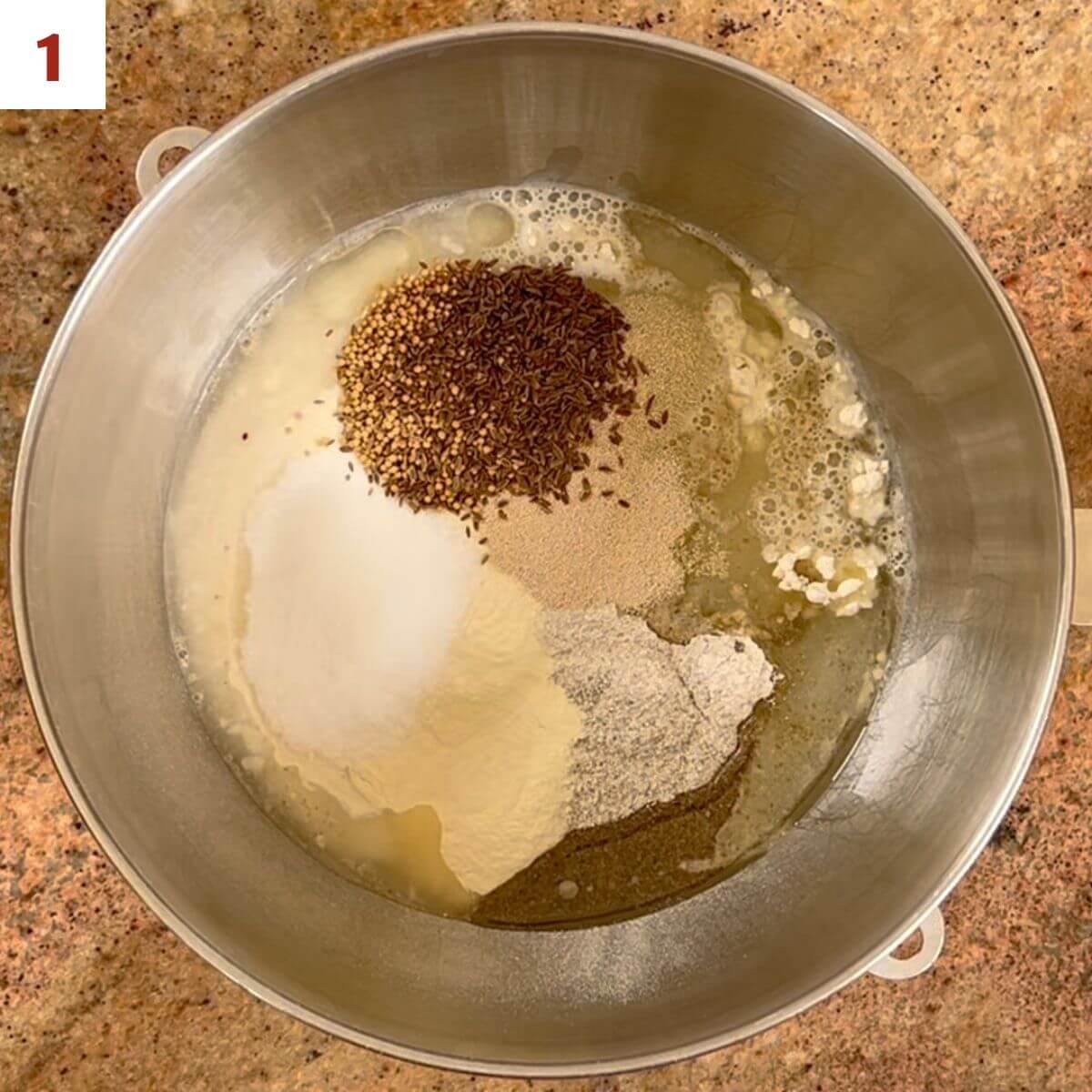
Step 2: Allow the dough to rise
Place the dough in a large bowl that's been lightly sprayed with canola oil spray. Cover the bowl and let the dough rise in a warm, draft-free place until it's puffy, about 1 to 2 hours (the oven with just the light turned on works well).
The dough should expand, but it may not double in bulk (photos 2 and 3).

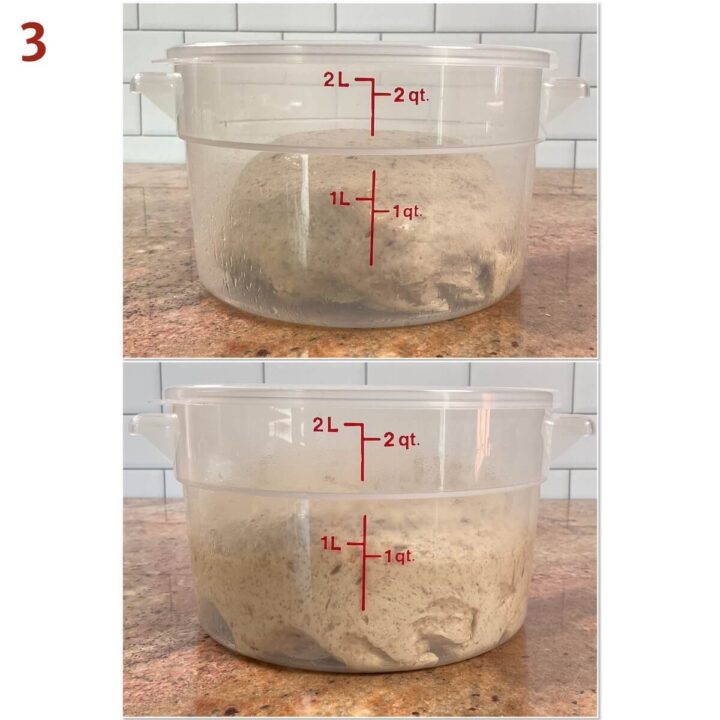
Step 3: Shape the bread
This is the same shaping method I used with my Multigrain Sourdough Bread. I also have an alternative shaping method below.
Gently deflate the dough, and shape it into a log. Start by flattening the dough with your hands into a rectangle about a ½-inch thick. Take the top 2 corners and have them meet in the middle to form a point at the top (like you're folding a paper airplane)(photo 4).
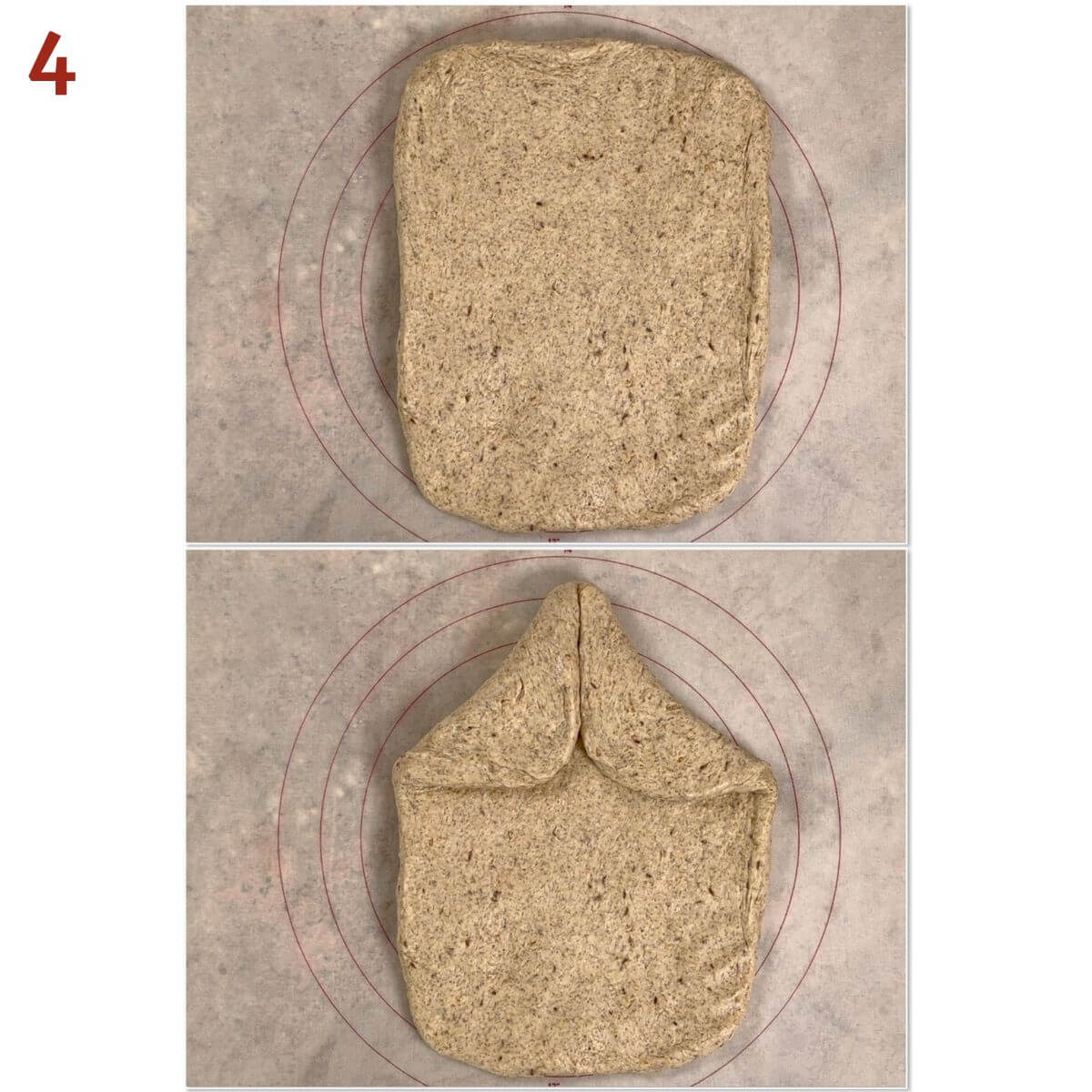
Fold the point over towards you so that it extends a little beyond the bottom edges of the folded corners, then repeat the process with the upper corners, having them meet in the middle again (photo 5).
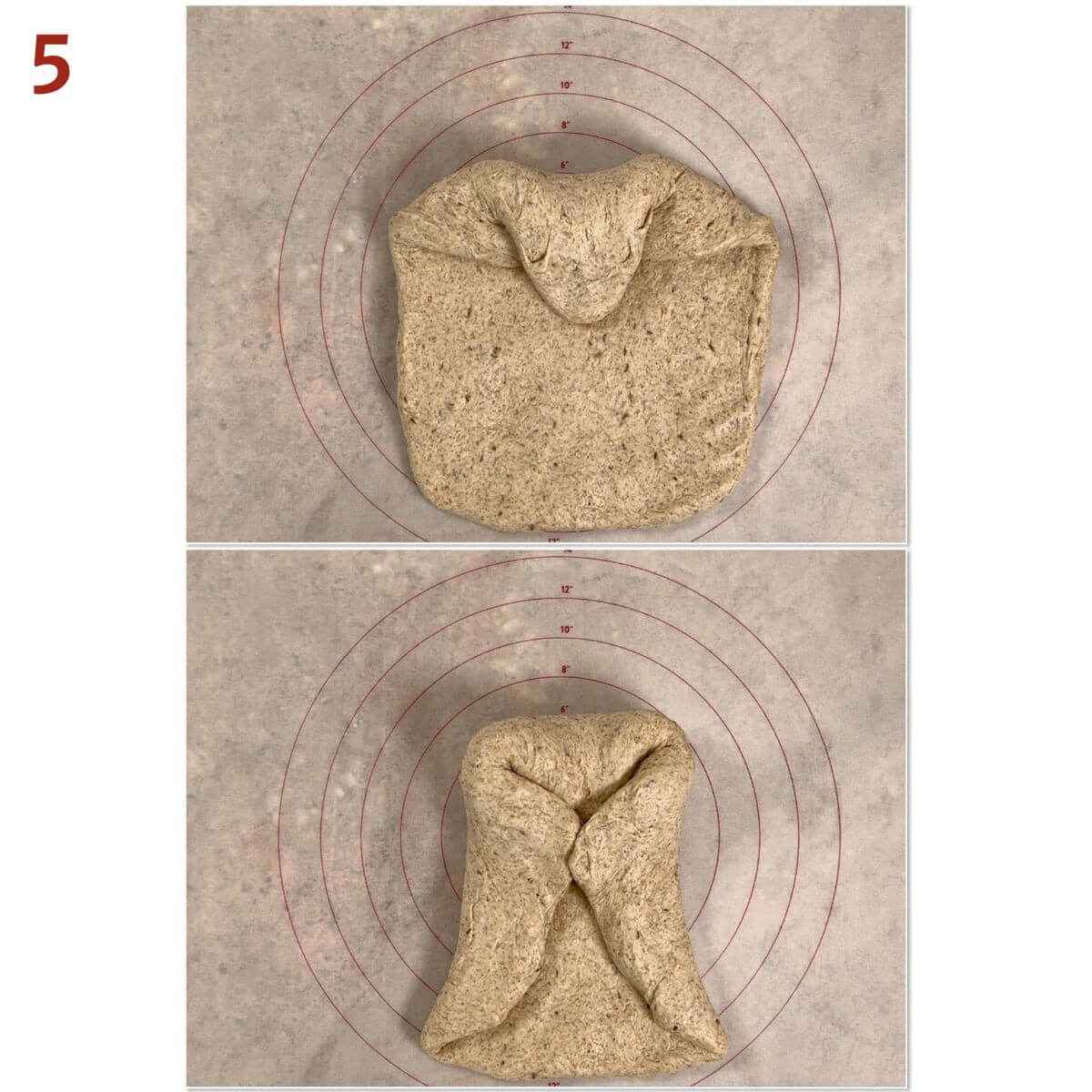
Roll the loaf over so the seam is at at the bottom. Gently roll the loaf back and forth to seal the seam while maintaining the loaf shape (photo 6).
Neat, huh!
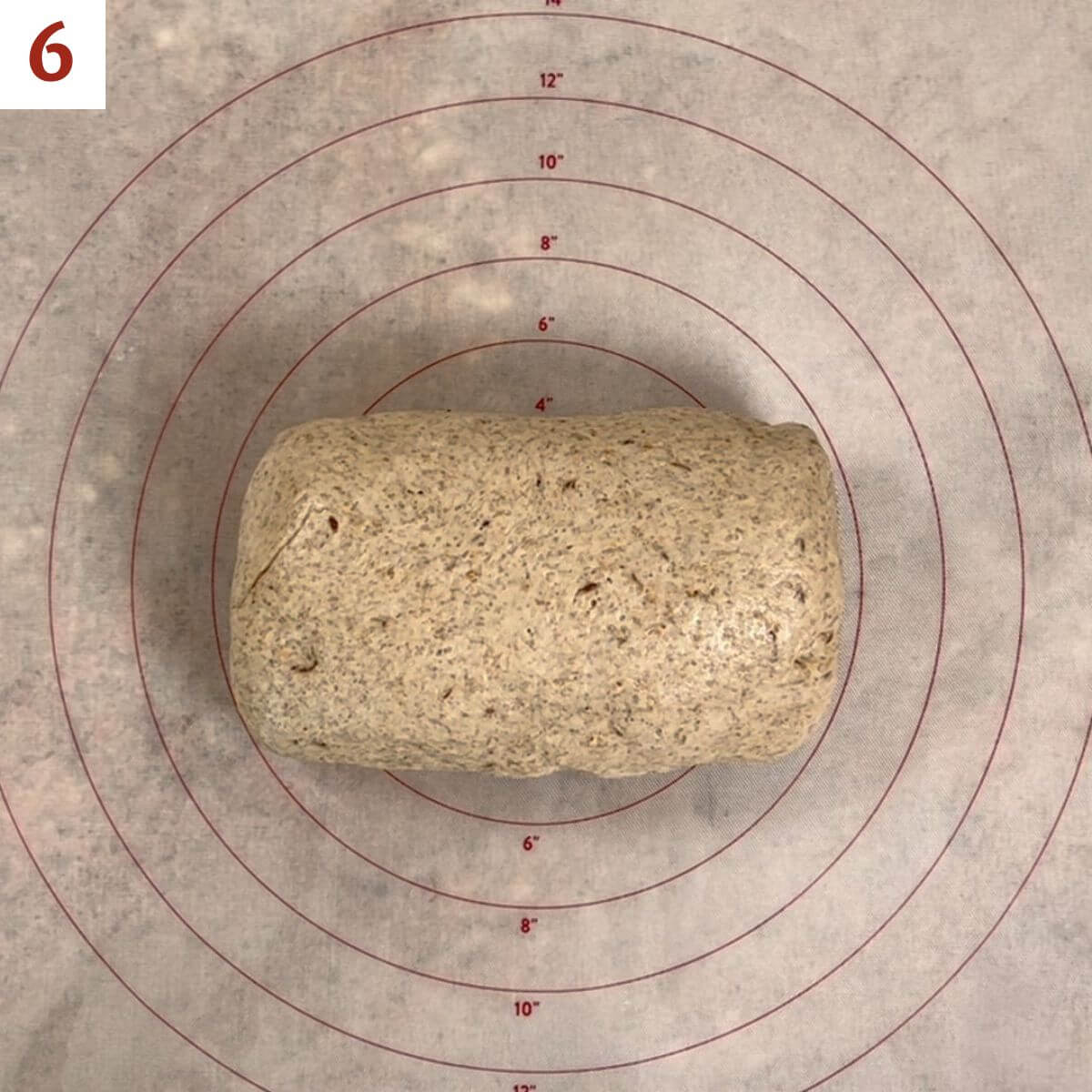
Step 4: Allow the dough to rise again
Place the shaped loaf in a standard loaf pan sprayed with canola oil spray, then press it flat to reach close to the corners of the pan (photo 7).
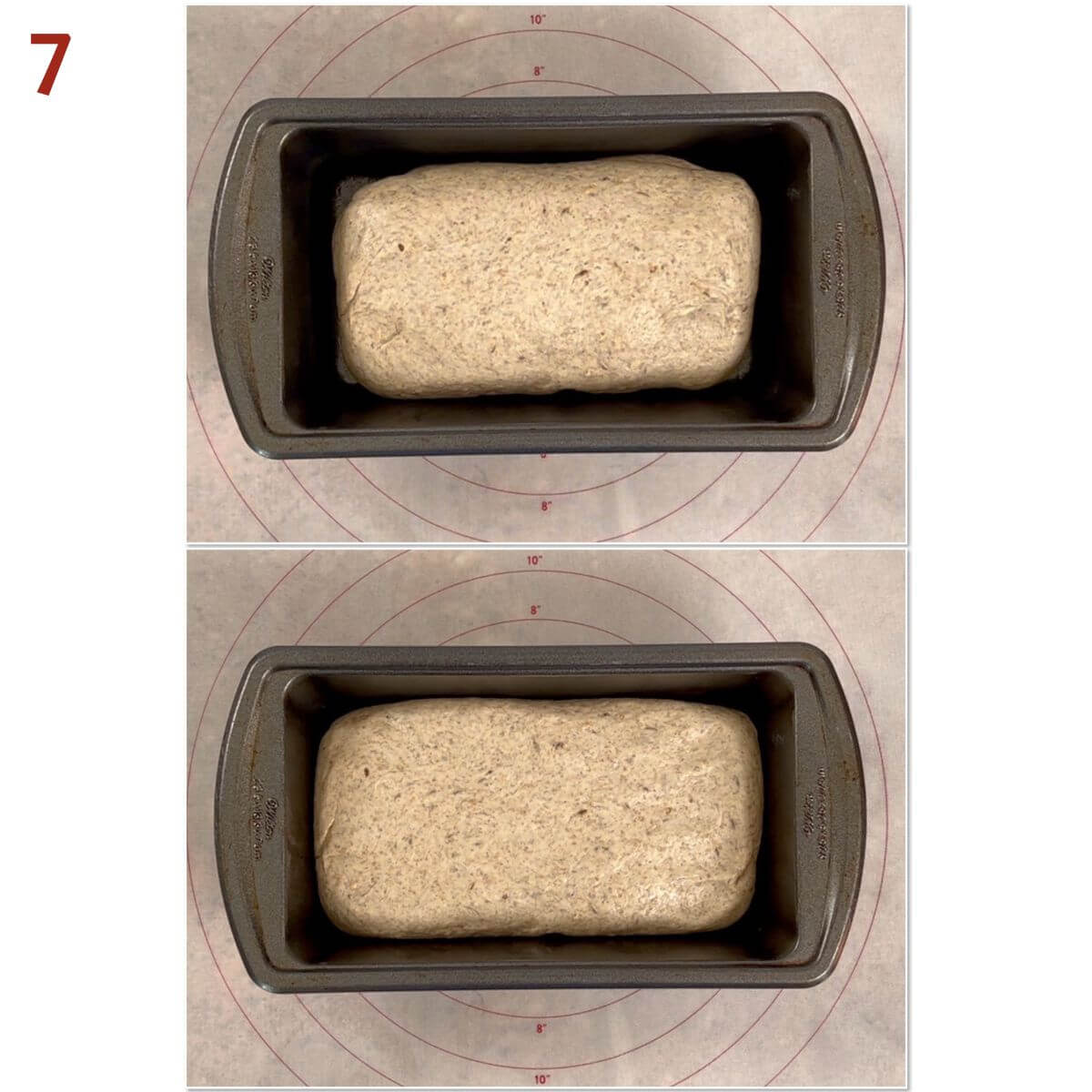
Cover the pan with greased plastic wrap, and let it rest until it has risen about 1 inch to 1½ inches over the edge of the pan, about 1 to 1½ hours (photo 8).
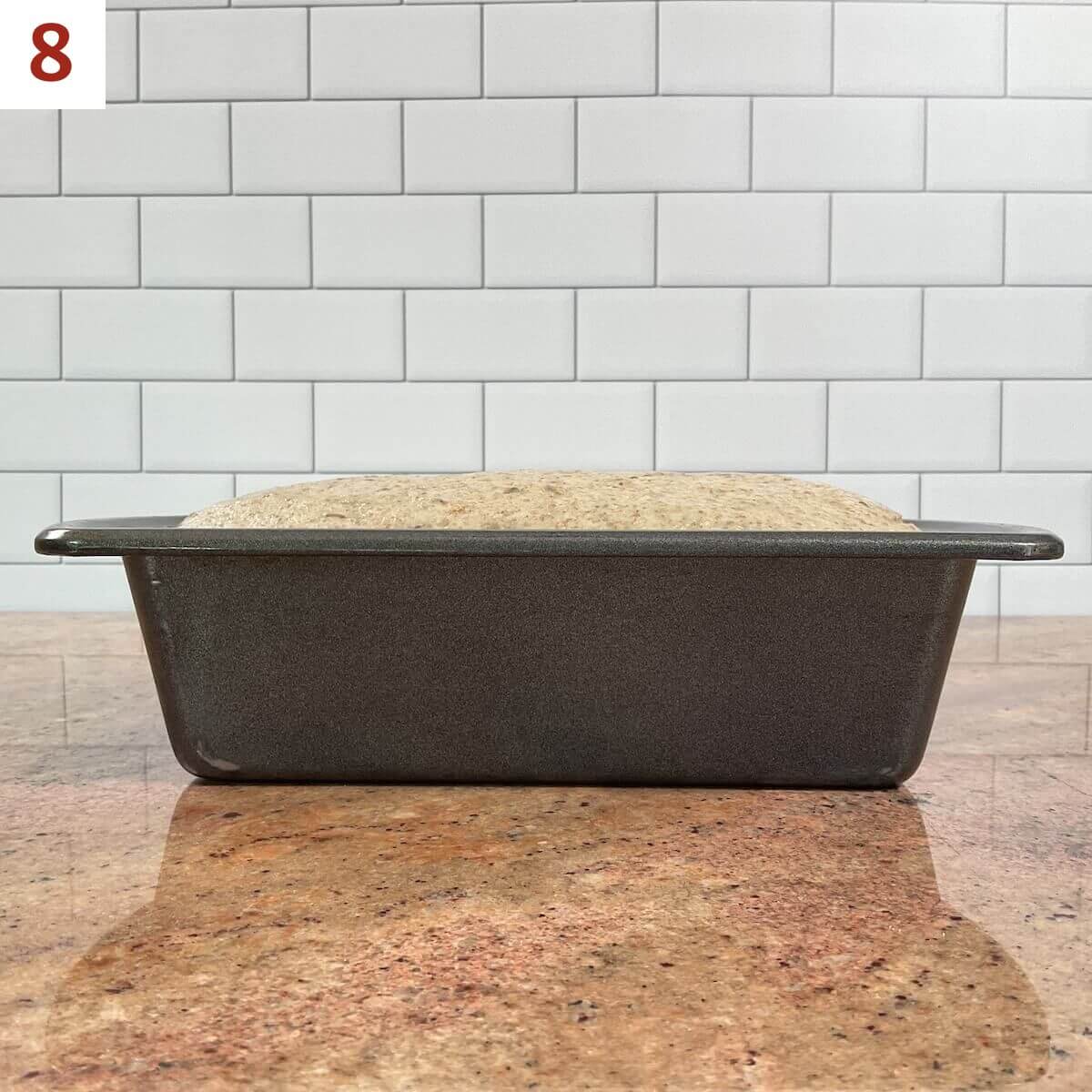
Step 5: Bake the bread
Bake the dough at 350˚F for 40 minutes, tenting with foil after 20 minutes. The bread will be golden brown (photo 9).
If you want to be sure, check the internal temperature with a digital thermometer. It should read at least 190°F.
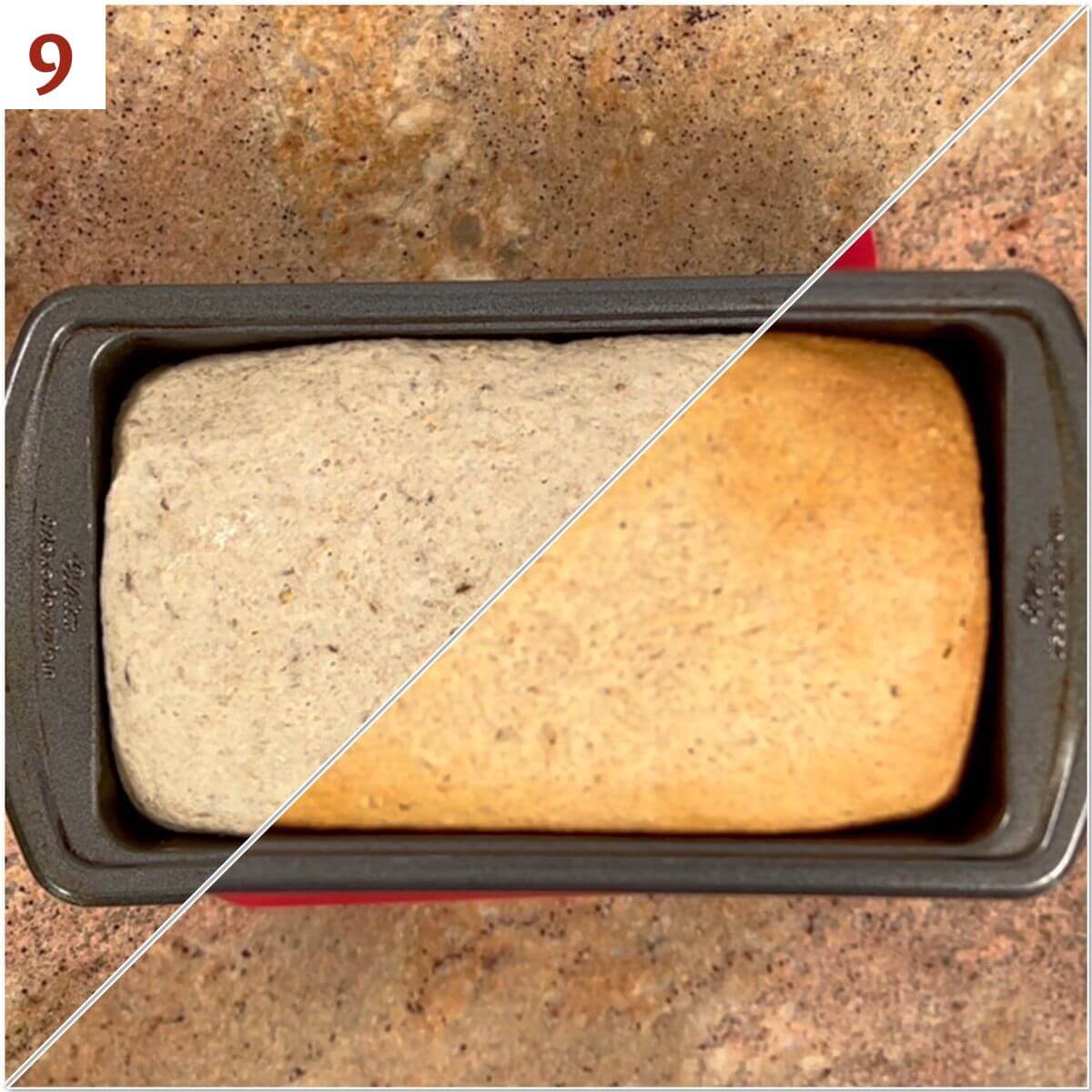
Storage instructions
Sourdough rye bread can be stored in an airtight container for up to a week at room temperature. For longer storage, place in an airtight bag and freeze for up to 3 months.
Alternative bread shaping technique
Techniques for shaping bread dough into a loaf are many and varied. From shaping a babka to braiding challah, fancy loaves are fun to make. But what about shaping a simple loaf of bread? The idea is to create a tight outer shell that the yeast can push against so the bread rises. The denser the dough, the harder the yeast has to work.
Here's another bread loaf shaping method (seen here shaping Colonial Bread, a Southern brown bread):
- Place the dough on a lightly floured surface and lightly knead for a few minutes
- Pat the dough into a rough oval slightly less than the length of your loaf pan. Fold the top third over (like a letter), and use the heel of your hand to seal the seam
- Turn the dough around and repeat with the other side
- Fold the dough in half, and press the seam again, pressing it down onto the work surface
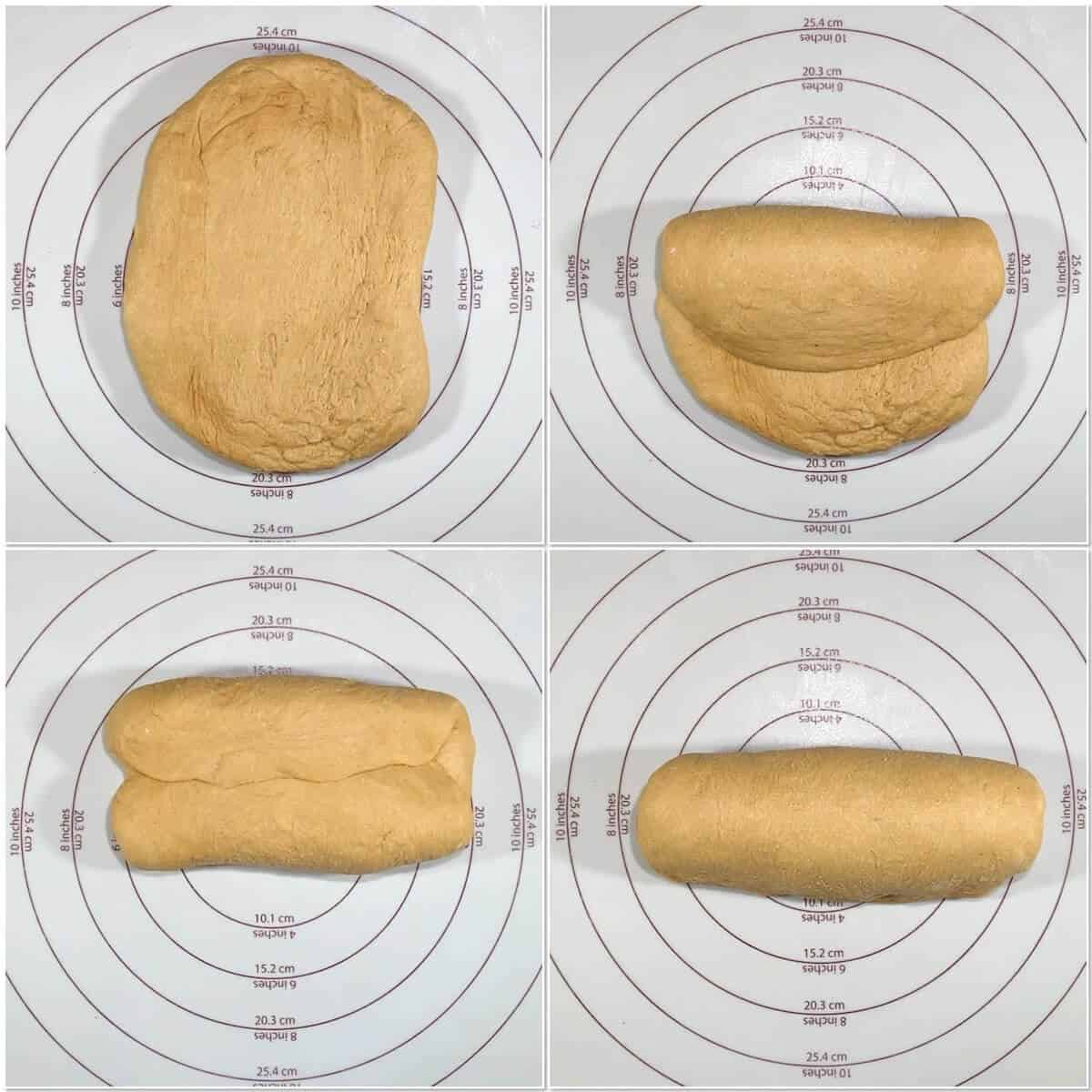
Questions asked and answered
Here are some questions you might have...
Breads made from rye flour will be denser than wheat breads because rye flour contains less protein, inhibiting the creating of the gluten structure needed to let the bread rise (why rye breads don't rise as much). To counter that density, you can include bread flour (which has a higher protein content than all-purpose flour) to add lift to the bread dough.
Since rye flour has less protein, it doesn't have the structure to create the gluten network needed. If your rye bread recipe contains bread flour, that will help to develop the gluten network.
For this sourdough rye bread recipe, it's best to use a stand mixer or bread machine for kneading, otherwise it's hard to develop the gluten sufficiently. If you do knead by hand, realize that the dough will take longer to rise, and won't rise as high.
Potato flour will help increase the moisture level in bread, making the bread dough easier to work with. That's especially helpful in developing the gluten network in rye bread recipes.

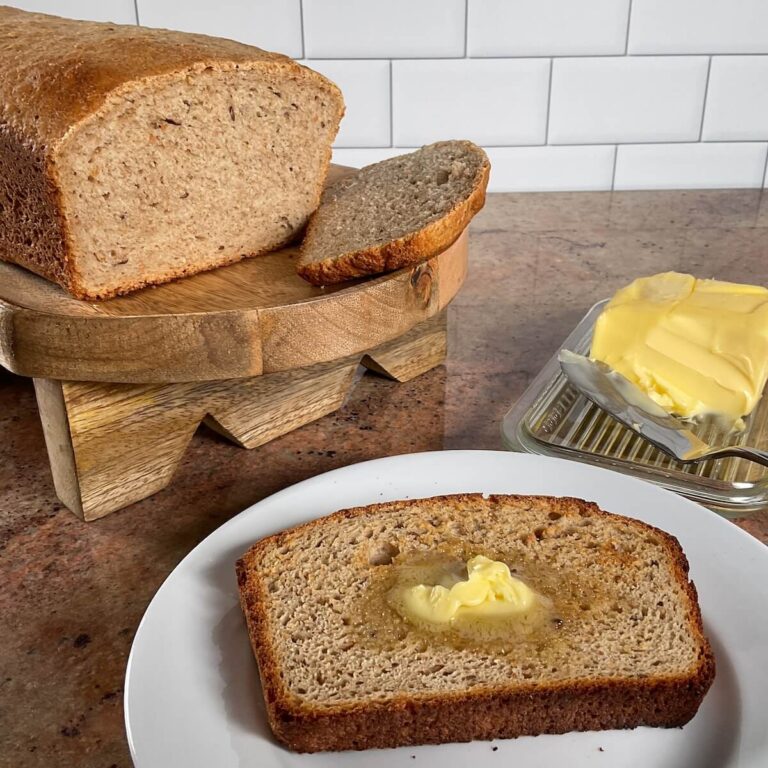
More recipes featuring sourdough discard to try
Recipe

Sourdough Rye Sandwich Bread
Equipment
- stand mixer with dough hook attachment or bread machine
Ingredients
- 1½ cups bread flour
- 1⅓ cups rye flour
- 1 cup sourdough starter discard, unfed, at room temperature
- ¾ cup dill pickle juice, warmed between 100°F to 110°F
- ¼ cup potato flour, or ¾ cup (146 grams) instant mashed potato flakes
- ¼ cup canola oil
- 3 tablespoons water, warmed between 100°F to 110°F, see Recipe Notes
- 1 tablespoon granulated sugar
- 1 tablespoon yellow mustard seeds, or prepared Dijon mustard
- 2½ teaspoons instant yeast, or Active Dry, see Recipe Notes
- 1½ teaspoons kosher salt
- 1¼ teaspoons caraway seeds
- 1¼ teaspoons dill seeds
Instructions
- Make the dough: Combine all of the ingredients in the bowl of a stand mixer. The dough may feel dry, so let the dough rest for 20 minutes. The resting time allows the flour to start to absorb the liquid, so don’t skip this step!
- Knead the dough using a stand mixer fitted with the dough hook (or bread machine set on the dough cycle) to make a stiff, but fairly smooth dough. If it seems too wet or too dry, add in all-purpose flour or water, a tablespoon at a time. The dough will be soft and sticky.
- Place the dough in a large bowl that's been lightly sprayed with canola oil spray. Cover the bowl and let the dough rise in a warm, draft-free place until it's puffy, about 1 to 2 hours (the oven with just the light turned on works well). The dough should expand, but it may not double in bulk.
- Shape the loaf: Gently deflate the dough, and shape it into a log. Start by flattening the dough with your hands into a rectangle about a ½-inch thick. Take the top 2 corners and have them meet in the middle to form a point at the top (like you're folding a paper airplane). Fold the point over towards you so that it extends a little beyond the bottom edges of the folded corners.
- Repeat the process with the upper corners, having them meet in the middle again. Fold the point over (it won't be as pointy, but that's ok). Roll the loaf over so the seam is at the bottom. Gently roll the loaf back and forth to seal the seam while maintaining the loaf shape. See the post for pictures of the process.
- Place the dough log in a lightly oiled standard loaf pan, and press it to reach close to the edges of the pan with a flattened hand. Cover the pan with greased plastic wrap, and let it rest until it has risen about 1 inch to 1½ inches over the edge of the pan, about 1 to 1½ hours. While the dough is rising, preheat the oven to 350 °F.
- Bake the loaf: Bake the bread for for 40 to 45 minutes, tenting with foil after 20 minutes. The bread will be golden brown. If you want to be sure, check the internal temperature with a digital thermometer. It should read at least 190 °F.
- Remove the bread from the oven, cool for 5 minutes, then remove it from the pan and allow it to cool completely on a rack. Slice and enjoy a delicious sandwich!
- Storage instructions: Sourdough rye bread can be stored in an airtight container for up to a week at room temperature. For longer storage, place in an airtight bag and freeze for up to 3 months.


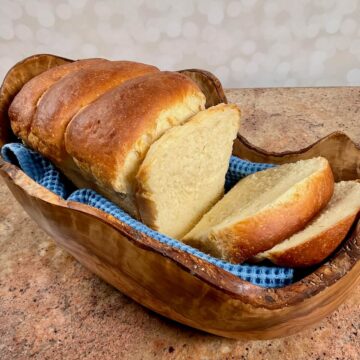
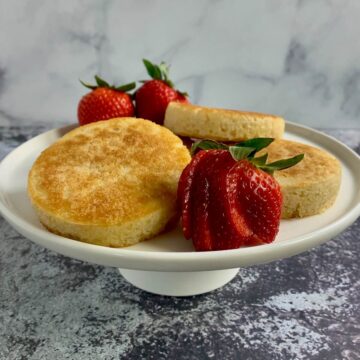

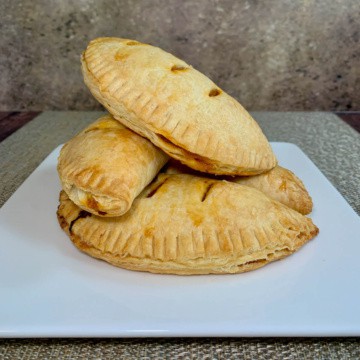
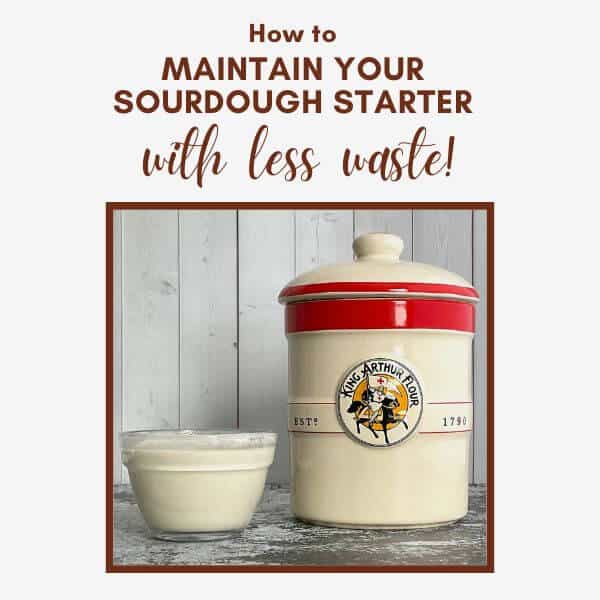
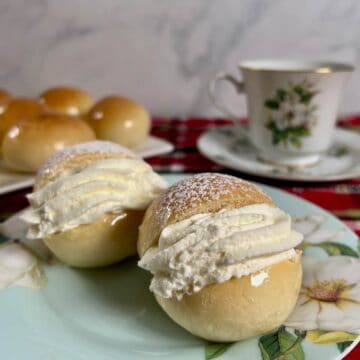
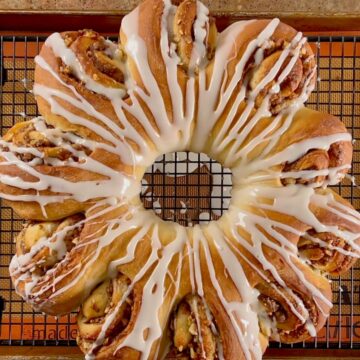
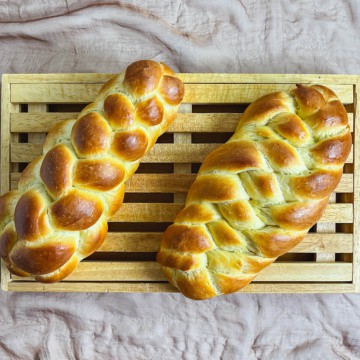
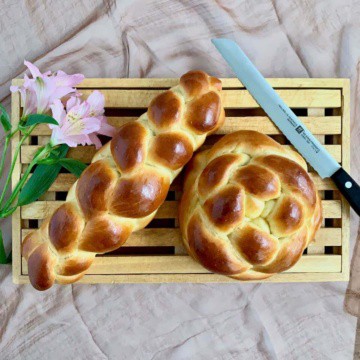
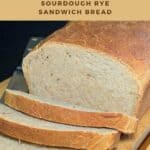
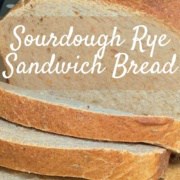
Julz says
Mine did not rise very much so bread was quite dense. Tastes good but not soft at all. Will not make again.
Tammy Spencer says
Hi Julz, I'm sorry you had trouble with the bread rising. As I said in the post, breads made with rye flour will tend to be denser (rising less) because it contains less protein than wheat flours. Using bread flour helps to counteract this by increasing the protein content, thus increasing the gluten formation and helping the dough to rise. Still, this bread will be denser overall than a regular sandwich bread, like this sourdough discard sandwich bread.
Christine says
Was so excited to try this recipe and made it last night. I could not find the potato flour at my store, which is usually available, (thanks supply lines). I used 3/4 cup of instant massed potato but was using the metric measure for everything else, which would have required close to double the amount of instant mash. I also used instant yeast. Regardless the bread was flavorful fresh from the oven. It did not rise as much as I would have preferred, but still delicious. Today I cut slices for sandwiches and the dill pickle juice taste was quite strong. So my recommendations are, use real potato flour and if not eating the entire loaf in one sitting, maybe back off the dill pickle juice so your leftover bread will be more like rye bread.
Vanessa says
Thank you for having us measurements. . .i am staring the bread now.
Tammy Spencer says
You’re welcome. Please let me know if you have any questions, or just how it came out. Happy baking! 😉
Hanne says
The recipe turned out fine, but at 350 F it took 60 minutes to bake the loaf and get a nice crust. I will try without the foil cover today and see how it goes.
Tammy Spencer says
Hi Hanne, Thanks for sharing. Since every oven is different, it may be that you need a slightly higher baking temperature, especially if the bread wasn’t browning after 20 minutes. You can try baking at 375°F and see if that helps. Let me know how it goes, and happy baking!
Christine Murray says
This was amazing, You are brilliant.
Tammy Spencer says
Thanks! I’m glad you enjoyed it 🙂
Summer Yule says
Yummy! This was a great bread to use with our corned beef for post-St Patrick’s Day reubens!
Tammy says
That sounds delicious! Thanks for sharing 🙂
Kira says
Love the tang from the pickle juice! Delicious
scotchscones says
Thanks!